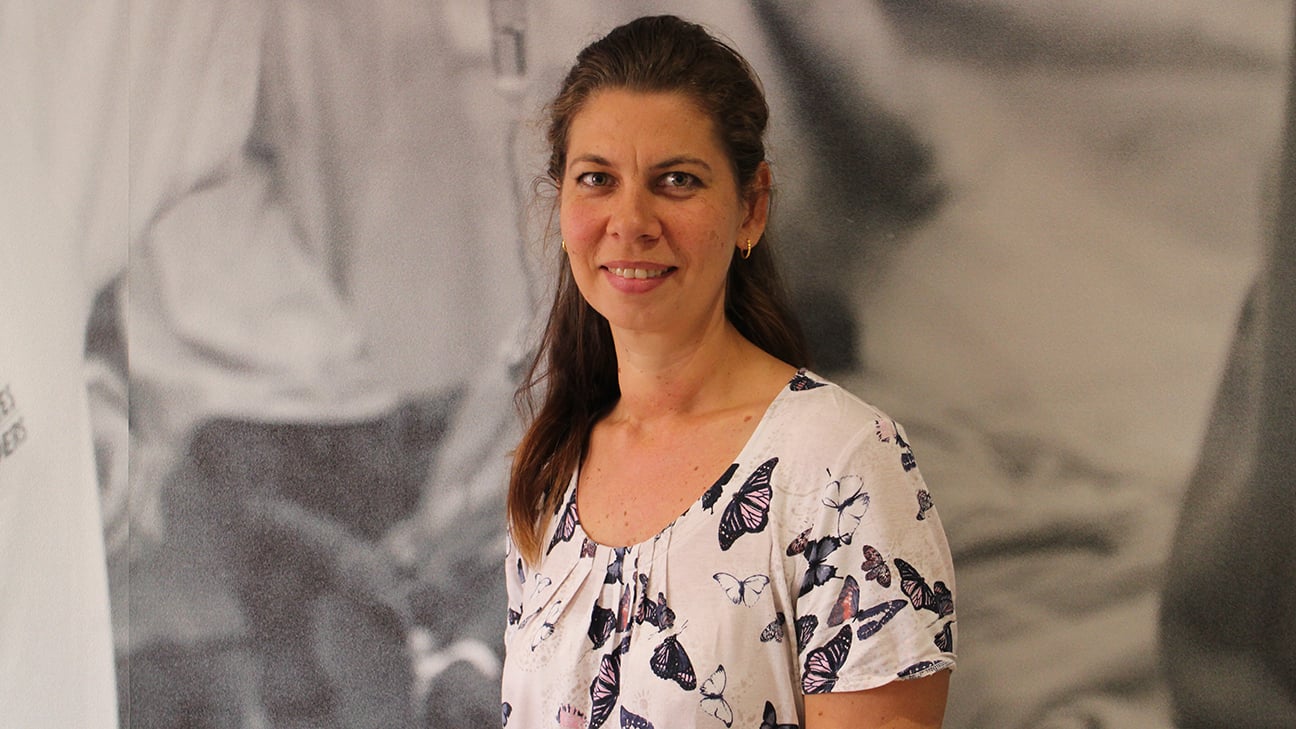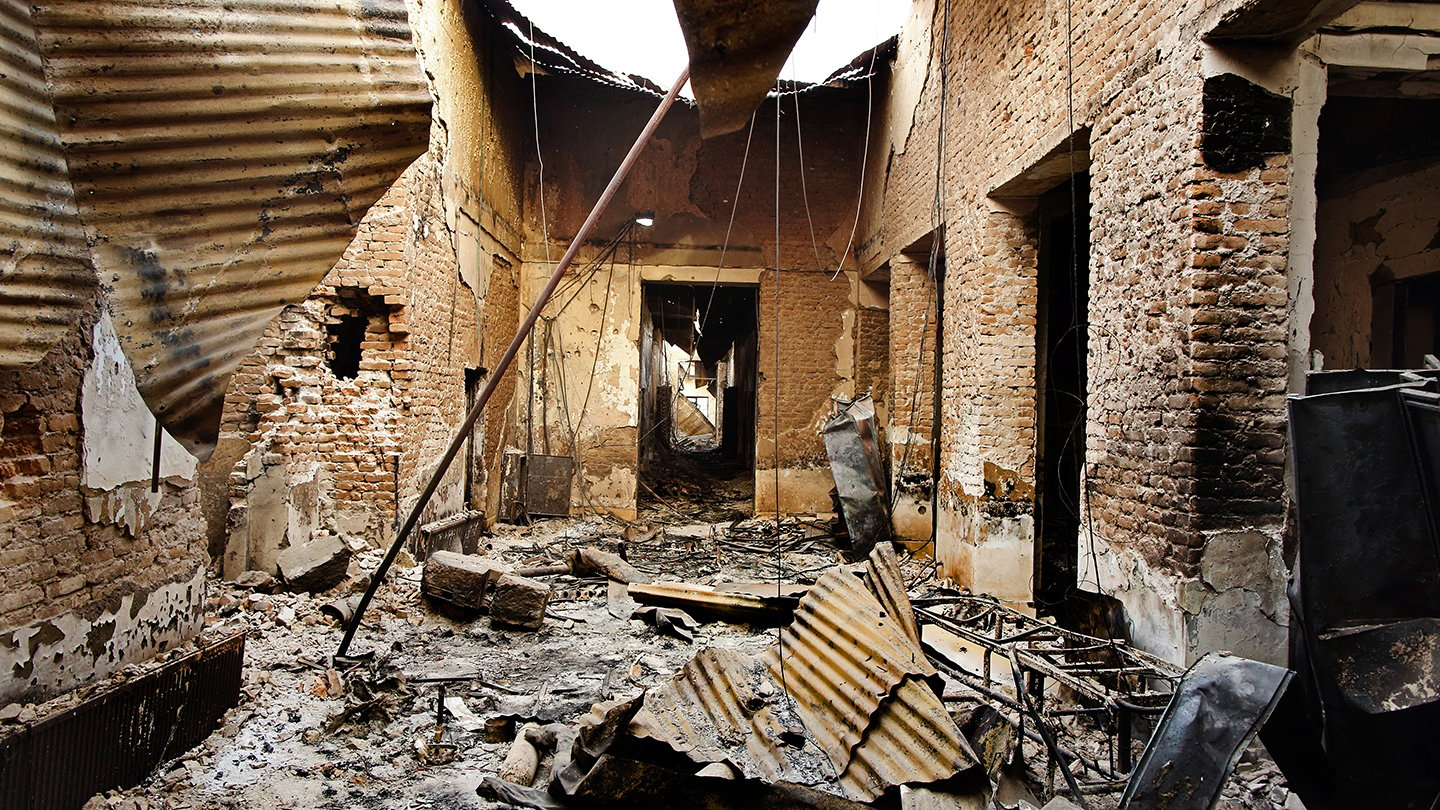The front gate at the MSF trauma hospital in Kunduz
Just after 2am on October 3, 2015, a United States Air Force gunship circled above the Afghan city of Kunduz.
For the next hour the flight crew unleashed a relentless barrage of 211 artillery rounds in an airstrike on a Doctors Without Borders (MSF) run trauma centre. Within minutes the entire hospital — the only medical facility in the area — was up in flames, and eventually completely destroyed. 42 people died that day, including patients, caretakers and medical staff. Jonine Lotter, a South African operating theatre nurse, was among the survivors of that attack. A year later she shares her story.

Operating theatre nurse Jonine Lotter at Doctors Without Borders (MSF) office in Johannesburg. (Photo: MSF)
In August 2015 I started my first assignment with MSF in Afghanistan, working as an operating theatre (OT) nurse supervisor at Kunduz Trauma Centre (KTC).
We treated all people with trauma injuries and wounds — regardless of who they were. To us it did not matter if someone was a civilian or an injured fighter, just that we saved lives and limbs.
On Monday September 28, fighting between the Taliban and the Afghan National Army and their allies broke out. The number of patients spiked, and we had to work around the clock for the next five days in order to provide treatment.
We worked, slept and ate inside the hospital, because it was too dangerous to leave the grounds, sometimes even too dangerous to leave the hospital building, for fear of stray bullets hitting you.
In my 15 years as an OT nurse, I saw many trauma patients, but nothing prepared me for the hospital that week. Everywhere — on the floor, in the corridors — there were wounded patients fighting for their lives.
By Thursday 1 October the fighting outside abated, and on Friday October 2, it slowed enough that I left the OT early — by 23:00 — to get some sleep. “Tomorrow we can start with a clean board, no emergencies,” I thought.
I slept in a meeting room in another part of the hospital compound which I shared with two colleagues. On other days, I would wake up from the sound of shooting outside, but that night was quiet.
Until the bombs hit.
It was an unbelievably loud sound. At first we didn’t know what was happening, just that the walls, the floor, everything shook with the force of it.
“It’s a bomb. They are bombing us!” one of my colleagues said. The fear and terror I felt is something I cannot put it into words. The bombardment was continuous — one hit after the other. The three of us huddled in the small, bare room looking for the safest place in the dark.
Suddenly one of our Afghan colleagues burst in. It was like a scene from a horror movie; his left arm was shot away, a traumatic amputation. He was confused, in shock, and did not know where he was. We got him to lie down, noticing that his hair and face were covered in dust, his clothes soaked in blood.
“What happened?” we asked.
“It is all gone. They are all gone,” he said.
“Is this it?” we wondered. “Are we the only ones alive? Where do we go from here? What about the patients, our colleagues? “
With a small emergency aid kid, we set to work trying and save our colleague’s life. We tried to stop the bleeding with bandages, but there wasn’t much we could do. He needed a hospital, an emergency room. In the end, we couldn’t save him.
The meeting room became a triage room. More staff and wounded arrived. People who were colleagues a few hours earlier now became patients. We needed to operate but we had no instruments.
It was a long and difficult night. But something inside me said “you cannot stand here and just watch. Do something, try and help”. So we worked until sunrise, when we heard that we would be evacuated.
Outside, the scene was unbelievable: The emergency room, gone. The intensive care unit, gone. The operating theatres, gone. There was nothing left.

Iron roofing and rubble litter a corridor in the MSF Kunduz Trauma Centre following the October 3 aerial attack which killed 22 staff and patients in northern Afghanistan. (Photo: Andrew Quilty)
I was grateful to be alive, grateful that I hadn’t been inside the main hospital building when the airstrike hit. But I was in disbelief. I wondered how it could be real, that this place that was a hospital now looked look like a warzone.
I thought about the patients — those in the ICU, in the ER — they were all dead. And what about the ordinary people we treated before? Their injuries were such that they needed follow-up visits. What would happen to them now? This was the only hospital for hundreds of kilometres. It was all people had in Kunduz. Where would they go now?
Fourteen MSF staff members, four caretakers and 24 patients died inside the hospital that day — burned to death, or blown into unrecognisable pieces. A year later, there are no clear answers about why it happened.
Before that night, we all believed that the hospital was the safest place in Kunduz city — as all medical facilities should be in places of conflict.
It is a year later, and we are still waiting for an independent investigation. Not only on why the hospital in Kunduz was targeted and destroyed, but why hospitals in Syria, Yemen and Sudan are still being attacked and destroyed today.
Afghanistan, Yemen and Syria might be far away from South Africa, but I’ve seen that people are the same all over.
People have the same dreams for their families — despite living in a different country, or even in war. All over the world patients have the same need for medical care that doesn’t take sides.
We need you to stand with us and send a clear message to governments, militaries and armed opposition groups during conflict:
Stop these attacks — medical facilities, patients and health workers are not targets.